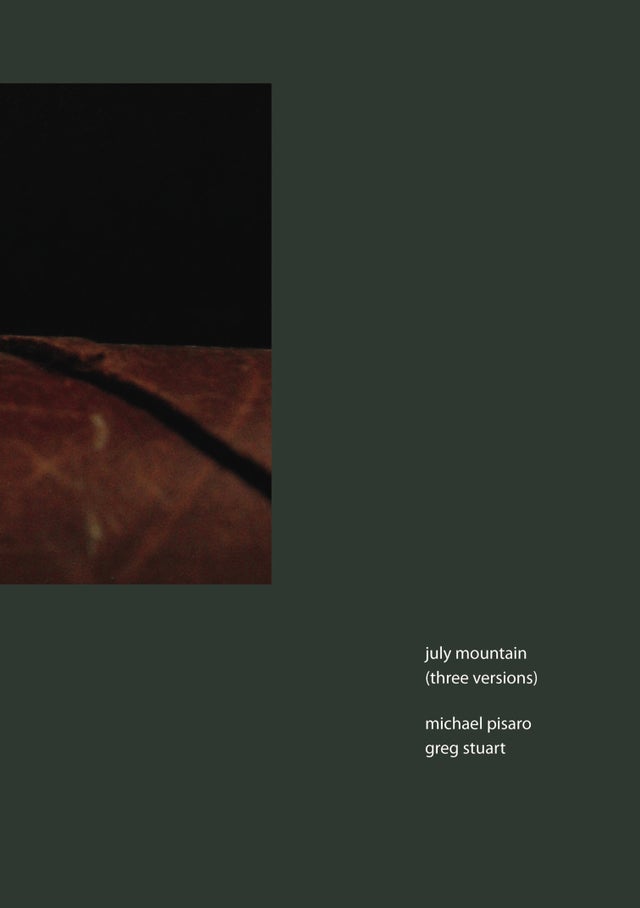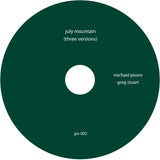Michael Pisaro/Greg Stuart - July Mountain (three versions) (CD)
SKU:
$14.00
$12.00
$12.00
On Sale
Unavailable
per item
GW 002
The second release from Michael Pisaro's label Gravity Wave. CD inside a cardboard folder with liner notes by Michael Pisaro, transparent plastic cover.
The second release from Michael Pisaro's label Gravity Wave. CD inside a cardboard folder with liner notes by Michael Pisaro, transparent plastic cover.
|
TRACK LIST/CREDITS
Michael Pisaro - composition Greg Stuart - percussion, instrumental recording, mixing 1. California Version: field recordings made by Michael Pisaro in various locations in California, 2006-2009. Final mixing and mastering by Michael Pisaro. 2. Instrumental Version: This version of the percussion part without the field recordings can be listened to by itself; or it can be used in case listeners would like to make their own version of the piece, by adding the 20 field recordings themselves. 3. Austin version: This version, with field recordings by Greg Headley, Jez Riley French, Travis Weller, Greg Stuart and Michael Pisaro, was prepared (and mixed) by Greg Stuart for a performance in Austin (by the New Music Co-op) in February of 2010. "July Mountain" was one of Wallace Stevens's final poems. cover photo by Greg Stuart design by Yuko Zama |
Gravity Wave 002, 'July Mountain: three versions', contains a re-release of this 21-minute piece for field recordings and percussion (the original .point engraved edition is sold out), along with two additional versions (one with alternate field recordings by a range of artists, and one with the percussion parts alone, which can either be listened to on its own or combined with field recordings of the listener’s choice). The work is a translation of Wallace Stevens’ poem “July Mountain” into sound. There are 20 field recordings and nearly 100 separate percussion tracks.
REVIEWS
Lucas Schleicher, Brainwashed Wallace Stevens wrote “July Mountain” in the last year of his life, suffering from stomach cancer. A recognition of mortality and imperfection hides in his poem’s first eight lines. They gently and beautifully remind the reader that life on earth is a fragmented thing, and that there are no conclusions, no full and final stops that shine a light on all the dark corners in the world. Instead we are all “thinkers without final thoughts in an always incipient cosmos,” forever watching the world and the stars spin themselves into new configurations. The poem explicitly uses music as an image for that interminable metamorphosis, and Michael Pisaro’s composition of the same name demonstrates just how apt an image it is. July Mountain (Three Versions) illustrates Stevens’s contention, combining field recordings with incredibly stealthy musical contributions provided by Greg Stuart. Bowed snare drums, piano, bird calls, jet engines, and numerous other sounds, from sine tones to insects, unexpectedly coalesce over its 21 minutes, forming a quivering and effervescent peak for anyone willing to make the ascent. July Mountain first appeared as a single piece on a limited edition CDr released by Engraved Glass. To the “California Version” presented on that disc, the Gravity Wave release features two additional performances. One of them, the “Austin Version,” is a complete rendition, combining 20 field recordings unique to that city with 10 layers of percussion recorded by Greg Stuart. Instructions for how the field recordings are to be obtained are minimal (make 20 of your own, or get them from the composer, just make sure to point the microphones at mountains or valleys if possible), but their durations and their arrangements with respect to one another are very well defined. They are all ten minutes long, and there are only ever ten recordings playing simultaneously. On the percussive side, the featured instruments include resonating surfaces teased by sine waves, vibraphones wrapped in tin foil, and “seed rain,” a steady stream of seeds, rice, or beans poured over crotales or a glockenspiel (the score gives the performer plenty of choices). Their timings and durations are specified by time markers—four bowed wooden blocks at nine and a half minutes, one projected sine tone at five and a half minutes, lasting for seven minutes and thirty seconds—and the methods suggested for playing them, including the exact qualities to be elicited from them, are described rather than strictly notated. For example, the instructions for the bowed snare drum read, in part, “Sounds may be created by bowing on any part of the instrument and by bowing on a drumstick or doweling with its tip pressed against the drum.” In combination, these two elements are difficult to separate. Conglomerations of sound rise and fall together, smearing into agreement as they are carried away on the same breeze, cars buzz anonymously down lonely roads, storms rumble in the distance, and unidentifiable particles of noise slip in and out of earshot as naturally as the hum of traffic or the rush of wind through the leaves. No hint of instrumental interference is evident until some eight minutes into the song, when the first piano chord sounds. Greg Stuart has actually been playing for six minutes by that point, but it’s not easy to ascertain what belongs to him and what belongs to the mountains of California. The “Instrumental Version,” which omits all the field recordings, renders the extent of this subterfuge with shocking clarity, and is in some ways responsible for making July Mountain (Three Versions) such an eye-opening and enjoyable document. On its own, the music is lovely and unassuming. No matter how thick and confusing the recording becomes, the atmosphere stays spacious and inviting. It drifts without meandering, gradually gains density, and then slowly fades away, as if every element outlined in the composition had been captured all at once, completely by accident. Listening to the “Instrumental Version” adds insight, and a chance to hear how Pisaro and Stuart make the magic happen. It’s exciting to peak behind the curtain and get some sense of the process. Pisaro’s decision to include the final line of Stevens’s poem in the liner notes provides nearly the same kind of insight, though what it reveals is less technical and more poetic. Just as “Vermont throws itself together” as Stevens climbs the mountain, so too does July Mountain take shape as it is recorded, performed, and heard. Even with all the elements of the instrumental score cemented by a recording, a near infinite variety of performances is possible, each one an accumulation of local sensations captured and sent into orbit, together forming a constellation of perceptions. The work of the composer is discernible upon inspection, but the performance of the piece demands variety. No final mix follows, there’s no signature on the dotted line; it’s an ever-evolving network of coincidences, revelations, and possibilities. July Mountain comes together as we listen to it, maybe as all songs do. But as a composition it asks that we take shape with it. When the sounds finally stop, it must be that something in ourselves stops with it. (8/27/2014) |



